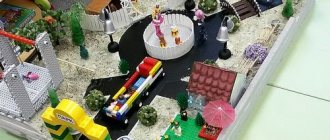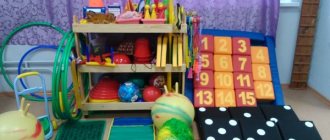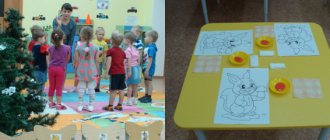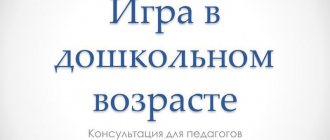Game layouts in the developmental environment of preschool educational institutions. methodological development on the surrounding world on the topic
Game layouts in the developmental environment of a preschool educational institution.
Play is the leading activity of the preschool period, the main content of children's life. While playing, the child communicates with other children and adults. Learns the world around him, learns to search, think and create.
At each stage of preschool childhood, play has its own characteristics. Thus, in the life of preschoolers, a new form of story-based play—directed play with small toys—occupies a large place. But in order for it to develop, kids need an attractive play space. Such a space could be a layout.
When playing with models, the child creates an imaginary situation and plays one or several roles. Simulates real situations or social relationships in a playful way. Layouts can have different themes, but in the process of their implementation several tasks are solved simultaneously and in parallel:
• consolidation and generalization of children's knowledge on a particular topic;
• activation of the lexical vocabulary;
• development of logical thinking, memory, attention, imagination, fantasy;
• development of general and fine motor skills of the hands;
• development of communication skills.
Games with layouts contribute to the development of initiative and volitional effort. Children designate a specific goal in the game, independently complement the layouts as they wish, using productive activities. Children's level of curiosity increases, they ask questions regarding objects and phenomena that lie outside the circle of direct observation (about nature, historical events, space, human health). Children include their new ideas in the plots of games and in the themes of drawings.
There are techniques that help increase children's interest in playing with models. This is, first of all, fiction that creates in the imagination of children various “worlds” with amazing characters and plots. Inhabitants-characters, additional items for the model can be made in the process of joint productive activity of children with the teacher (from paper, cardboard, wire and other waste material).
It should be noted that the layout is the central element that organizes the object environment for playing with small toys. It raises the ability to develop a plot to a new level, promotes the overall development of preschool children, and is a connecting link between various forms of adult-children and free children’s activity.
Layouts are smaller integral objects, models that display certain parts of the surrounding world and guide the child in play activities, creating plot stories and events taking place in this territory.
Games with layouts promote familiarity with the world around us, the development of creative cognitive thinking, the development of communication skills, monologue and coherent speech, as well as the ability to play in a team.
The use of layouts not only contributes to the development of role-playing play in preschoolers, but also enriches the subject-development environment in the group.
Development of gaming activity by means of prototyping.
Development of gaming activity by means of prototyping.
Annotation. The article reveals the possibilities of using prototyping to develop children's play activities, types of layouts, and requirements for their design.
Key words: play activity, director's play, layout, layout.
Currently, the need for important changes in determining the content of the educational process in kindergarten is undeniable. Each preschool institution independently determines the content and methods of organizing the pedagogical process. The staff of our kindergarten is also looking for new ways and forms of working with children in accordance with modern requirements, allowing for the integration of educational content when solving educational problems.
As you know, the main form of work with preschool children and the leading activity for them is play. What could be more interesting and meaningful for a child than games? This is joy, communication, knowledge, and creativity. While playing, a child communicates with other children and adults, learns about the world around him, acquires new knowledge, skills and abilities, learns to search, think and create. Play is of great importance in the development of a preschool child.
At each stage of preschool childhood, play has its own characteristics. Thus, a large place in the life of older preschoolers is occupied by director's play with small toys, when the child creates an imaginary situation, invents events with characters, identifying himself with them or distancing himself from them, performs one or several roles, and models real social relationships in a playful way.
In order for director's play to develop, preschoolers need an attractive play space. Such a space and central element that organizes an object environment for playing with small toys can be a layout.
Layout - (French maquette )
- a model of an object on a reduced scale or life-size, usually devoid of the functionality of the object being represented.
Layouts are divided into two types:
1. Layout models are reduced integral objects.
2. Layout maps that display a certain territory and guide the child to the development of plot events taking place in this territory and around the objects that design it. Layout maps are large planes with places for possible objects marked on them and several key objects - space markers. Thus, on the “City Street” layout map, roads and sites for buildings are highlighted in color; the territory is supplemented with several commensurate objects (houses, garages, overpass bridge). A landscape layout map is a plane with a natural territory (forest, river) indicated in color. , which is supplemented by several small markers freely placed on it - trees, a house, a fence.
Layout “My favorite kindergarten”
| Author: Gaifullina Liliya Khusametdinovna teacher NRM DOBU "TsRR-d/s "Teremok" highest qualification category teaching experience 20 years |
Methodological manual for kindergarten teachers
"My favorite kindergarten"
annotation
The preschool period is extremely significant for the child’s entry into the world of social relations, for the process of his socialization according to the statements of L.S. Vygotsky considers “growing into human culture.”
Social development is socialization, the process of assimilation and further development. Modern trends in the development of the education system in Russia are associated with the implementation of the request for optimal updating of its content and methods in accordance with the progress of society.
Preparing the younger generation for active creative life in the world community, capable of solving global problems of humanity.
The current state of science and practice of preschool education indicate the presence of enormous potential in the development and implementation of programs and technologies for the social development of preschool children.
This area is reflected in the requirements of the Federal State Educational Standard and is included in the content of federal and regional comprehensive and partial programs: “Childhood”, “I, You, We”, “Community”.
Social development is a process during which a child learns the values, traditions of his people, and the culture of the society in which he will live. The process of social development is a complex phenomenon, the entrance of which involves the child’s appropriation of objectively given norms of human society and the constant discovery of self-affirmation as a social subject.
The content of social development is determined, on the one hand, by the totality of social influences of the world level of culture, universal human values, and on the other hand, the attitude of the individual himself to this, the actualization of his own “I”, and the disclosure of the creative potential of the individual.
The relevance of the issue of social development of the individual has been unconditional throughout the entire period of human existence.
As a pedagogical problem, it was identified relatively recently at the end of the 19th century and was presented in the works of foreign scientists G. Tardo, E. Erikson, etc.
In domestic pedagogy, this problem is associated with the names of L.S. Vygotsky, T.V. Kudryavtseva, V.P. Zinchenko.
In preschool education, many of its aspects were updated and the early works of S.A. were also considered. Kozlova, O.L. Knyazeva, M.i. Bogomolova.
Social development is carried out in two ways, during the spontaneous interaction of a person with social reality and the surrounding world, in the process of purposeful introduction to social culture. The second path of social development is carried out through targeted education, the content of which is various aspects of social culture.
The implementation of social development tasks involves the construction of integral pedagogical systems that presuppose unity and interconnection.
Pedagogical science still has to solve a serious problem associated with the formation of a harmoniously developed personality. The child’s cognitive sphere is formed in the process of mastering the content field of theoretical and practical activity, the emotional and sensory world. Only a humanistically oriented educational process, the purpose of which is to meet the needs of the child, taking into account individuality and creating for this a whole range of humanistic, moral, aesthetic and organized pedagogical conditions.
The formation of children's personal culture is based on the child's gradual immersion in the environment and social environment, leading him to deep emotional perception and the desire to live in harmony with the outside world, in accordance with its laws.
Its implementation is possible subject to appeal to the ideas of humanity, responsibility and optimization of human-human relationships. But traditional pedagogical practice and pedagogical reality do not solve the problem of developing the social competence of preschoolers to the extent that it is presented in the historical-cultural and historical-pedagogical context, and to the extent that the current state of society requires.
Many famous teachers and philosophers paid attention to the need for early socialization of the child. This is Y.A. Komensky, Zh.Zh. Russo, I.G. Pestalozzi, K.D. Ushinsky, L.N. Tolstoy, V.A. Sukhomlinsky.
Scientists have proven that the microenvironment has a significant influence on the development of the individual; it is also one of the most important factors in the self-realization of the individual. Society as an objective social reality is a set of material, political, ideological and socio-pedagogical factors that directly interact with the individual in the process of his life, activity and communication. Communication in various spheres of a person’s microsociety is not only interpersonal interaction, but also a certain system of social relations.
“Socialization is the development of a person throughout his life in interaction with the environment in the process of assimilation and reproduction of social norms and cultural values, as well as self-development and self-realization in the society to which he belongs.”
The social development of a child is a process during which the child learns the values, traditions, and culture of the society in which he will live. He learns to live alongside others, taking into account their interests, rules and norms of behavior in society, that is, he becomes socially competent. When a child communicates with the world of adults, their activities, the world of feelings and experiences, i.e. to everything that society lives by - a task that humanity has been solving since the time when it began to be realized in the transfer to each subsequent generation of the experience of the previous one.
Increasing social orientation in society, socialization of the child’s personality in modern conditions. In this regard, the following tasks are put forward:
- Formation and development of socially significant knowledge, skills, qualities, needs, motives and norms of behavior.
- Development of the child’s personality in activities controlled by a system of motives, the child’s entry into a new independent environment – adaptation – individualization – integration.
- Formation of a favorable environment for education and training, taking into account the age characteristics of the individual, strengthening the spiritual ties that educate and educate.
- Stimulating a child’s benevolent attitude towards social reality.
- Close connection with the life of the family and team.
Thus, despite the variability in the interpretation of the process of social development, it is possible to identify the following in its content:
Child-centered;
The primacy of emotional perception of the social world;
Self-knowledge as awareness of finding your place in the world of people;
Mastering the values and norms of the surrounding world;
Socialization as a triune process - adaptation, individualization, integration;
The process of socialization by mechanism coincides with moral education (formation of ideas, feelings, behavior)
However, in general, the issues of developing a child’s relationship with the world and himself in the preschool education system seem to have not yet been sufficiently studied. The problem of socialization is that from birth to 6-7 years of age, the foundation of children’s orientation values is laid; this stage of childhood is the most sensitive for introducing children to various types of activities, but certain difficulties are encountered along this path. What is happening in society is a fundamental change in the status of large groups of the population, turning them into socialized ineffective in the new conditions. Moving a person from region to region makes socialization problematic; this is of particular importance for people living in the Far North.
We have determined the essence of the socialization process in preschool age, which consists of a combination of adaptation and isolation of a person in the conditions of a specific region and the development of society.
Social adaptation in preschool age is a process and result that is associated with the formation of an individual as a social being. The effectiveness of socialization will presuppose a certain balance of adaptation and individual isolation of the child in a kindergarten setting. Here, in the process of a child’s education, there is an increasing accumulation of relevant knowledge and experience in simulating conflict or non-conflict behavior, avoiding compliance with social norms of behavior.
The most important role in the socialization of preschool children is played by teachers and educators of preschool educational institutions, using various means of socialization.
Ideas about the need to change the content of social knowledge of children of different ages;
The idea of normative mastery of pedagogical design and subordination of the socialization process to the basic psychological laws of development of the child as a social being;
The idea of technologizing this process;
The idea of constructing a system of criteria for the success of the socialization process.
The initial essential characteristics of the technology are defined by us in the following basic concept:
New organizational forms of management (marketing research, strategic planning, technologization of the educational process, monitoring, the impact of our technology on the final results - the social competence of preschool children).
In our opinion, the upbringing of a preschooler is non-secret socialization, being one of the components - the relative socially controlled socialization of the child in society and in the conditions of a preschool educational institution. As our research has shown, the main conditions for the effectiveness and implementation of the developed model in a preschool educational institution were the presence of a unifying goal, positive dynamics of personal socialization, a flexible type and democratic nature of the management structure of a preschool educational institution, high professional competence of the educational institution, the development of a whole set of measures that contribute to the process of socialization of a preschooler .
The following parameters serve as indicators of the success of the developed educational institution management model:
Creating favorable conditions for the process of socialization of preschool children, in particular the psychological climate in the team;
Ensuring close interaction between teachers and parents;
Creation of psychological and pedagogical monitoring on the dynamics of health, education and development of children;
Development of a methodological package for organizing the educational process with socially oriented emphasis and taking into account in the socially oriented process;
A methodological manual is a goal accepted and mastered by children, relevant to them - this is children's amateur activity, this is a specific practical creative activity, step-by-step movement towards a goal, this is a method of pedagogically organized development of the environment by a child, this is a link in the education system, in the goal personality development program. Therefore, the purpose of our manual was: to create a system of work on the social and cognitive development of a younger preschooler through familiarization with the immediate environment (kindergarten).
Tasks:
- Creating a developmental environment to solve the problem of children’s adaptation to kindergarten conditions.
- Increasing the cognitive activity of initiative and activity of pupils in the process of introducing universal human values to culture.
- Promoting confidence, independence and interaction with adults and peers
- Development of children's sustainable interest in creative exploration activities
- Formation of initial prerequisites for research activities.
- Enriching parent-child relationships with the experience of conducting joint activities.
Participants : children, kindergarten staff.
Problem: children do not know that there are many rooms in the kindergarten, they ask questions about whether there are other groups, what rooms they are.
Possible ways to solve the problem:
Teacher - conversations, stories based on pictures, excursions to neighboring groups.
Children are having conversations, asking questions at home, what kind of classrooms these are, etc.
Layout diagram of a kindergarten (from the inside)
Goal: To expand the scope of the child’s social activity and his understanding of the life of the kindergarten.
Tasks:
1. learn to compose a story using photographs - diagrams with sequentially developing actions
2.form the idea that there are many different rooms and classrooms in the kindergarten.
3. Develop a respectful attitude towards kindergarten employees
4. Instill a love for kindergarten
5. to cultivate a caring attitude towards the kindergarten, towards everything that is in the kindergarten, since it is all made by human hands.
6. improve knowledge that in kindergarten there are other groups to which children of different ages go.
7. find your way around the kindergarten building.
8. Theatrical activities.
Mathematical development
“Classification ”: Goal: developing the ability to classify according to a certain criterion. There are no rules given when completing this task. The child must independently choose how to divide the proposed figures into groups.
Instructions: “In front of you is a row of figures (objects). If it were necessary to divide them into groups, how could this be done?
Set of figures.
It is important that the child, when completing this task, finds as many grounds for classification as possible. For example, this could be a classification by shape, color, size; division into 3 groups: round, triangles, quadrangles, or 2 groups: white and non-white, etc.
“Fold the figures.”
Goal: developing the ability to analyze and synthesize the relationship of figures to each other by color, shape and size.
Role-playing games "Professions"
A role-playing game is a genuine social practice of a child, his real life in the society of his peers. Therefore, the problem of using games for the comprehensive education and development of a preschool child is so active for pedagogy. An important role in maintaining gaming activity, introducing creativity into it, and creating interest in the game undoubtedly belongs to the teacher. Only an experienced teacher who knows and takes into account the individual and age characteristics of preschool children, who knows how to create play associations not at his own discretion, but based on the interests of the children, is able to make role-playing play an exciting process, during which children are drawn into close-knit groups and can realize themselves and willingly participate in game activities.
We read such works of art by E. Kazakova “The Hasty Knife”, E. Kazakov “Chick-Chick with Scissors”.
Played through game situations with the children: - Doll housewarming.
Puppet kindergarten.
Where children, in their play, expanded the scope of their social activity, the idea of a kindergarten.
We play role-playing games: - “Olya is visiting”,
- "Kindergarten"
-“A Journey Through Kindergarten”
Theatrical activities
Theatrical games allow solving many pedagogical problems related to the formation of expressive speech, intellectual, communicative, artistic and aesthetic education, the development of musical and creative abilities.
Theatrical play is the acting out of literary works (fairy tales, short stories, specially written dramatizations). The heroes of literary works become characters, and their adventures, life events, changed by children's imagination, become the plot of the game. It is easy to see the peculiarity of theatrical games: they have a ready-made plot, which means that the child’s activity is largely predetermined by the text of the work.
The theme and content of the theatrical play has a moral orientation, which is contained in every fairy tale and literary work and should find a place in improvised productions. This is friendship, responsiveness, kindness, honesty, courage. The characters become role models. The child begins to identify himself with his favorite image. The ability to such identification allows one to influence children through the images of theatrical play. With pleasure, transforming into a favorite image, the baby voluntarily accepts and appropriates his characteristic features. Independent role-playing by children allows them to develop the experience of moral behavior and the ability to act in accordance with moral standards. Because positive qualities are rewarded and negative ones are frowned upon, children generally want to emulate kind, honest characters. And adults’ approval of worthy actions creates in them a feeling of satisfaction, which serves as an incentive to further control their behavior.
The great and varied influence of theatrical games on a child’s personality allows them to be used as a strong, unobtrusive pedagogical tool, since the child himself experiences pleasure and joy. The educational possibilities of theatrical games are enhanced by the fact that their topics are practically unlimited. It can satisfy the diverse interests of children (literary, musical). The variety of themes, means of representation, and emotional theatrical games make it possible to use them for the purpose of comprehensive education of the individual.
Educational situations on traffic rules
Street model - a ready-made model or made from non-traditional material. The content becomes more complex according to the age of the children.
Purpose: to teach children to distinguish between the roadway and the sidewalk; to form an idea of the purpose of green and red traffic lights. Goal: to reinforce in children the idea that they cross the street in special places and only when the traffic light is green
I told various stories from the series “When I was little. I went to kindergarten...”, the content of these stories was filled with various educational information about kindergarten.
Conducted a visit to the children of neighboring groups, the 1st and 2nd junior groups, got to know the children, taught how to treat the kids with care, and the ability to help them.
— We got the opportunity to see and evaluate the result (product of our labor) of joint activities,
-see the social significance of the project, the contribution of each child, parent, teacher,
-experience vivid emotional feelings of joy, pride, responsibility,
-increase the level of social activity.
Educators:
- there is an opportunity to understand how parents motivate their children and help them solve problems,
- found out what hobbies and activities the adult family members and children have.
-created an atmosphere of trust, openness, mutual understanding,
-created the album “Kindergarten Employees”
-layout diagram “Kindergarten from the inside.”
Dear teachers and parents - participants of the exhibition!
On June 2, 2015, a solemn ceremony of awarding the winners of the regional methodological exhibition “Modern educational environment of kindergarten and family” took place at the information and exhibition complex of the Tyumen Regional Duma. Details >>>
From June 8 to June 10, 2015, teachers from Tyumen received certificates of exhibition participants and multimedia albums with the full version of the exhibition at the Grant Center for the Development of Creativity for Children and Youth at the address: Profsoyuznaya St., 52. tel. for inquiries: 685-321,
June 9, 2015 Diplomas, certificates and gifts were sent to the winners and participants of the Exhibition of the south of the Tyumen region, Yamal-Nenets Autonomous Okrug and Khanty-Mansi Autonomous Okrug-Yugra by registered parcel post to the address of the preschool educational institution. Details >>>
Share





